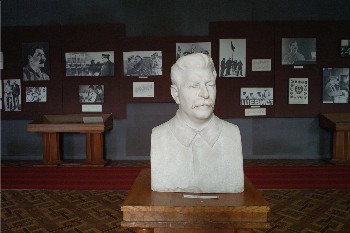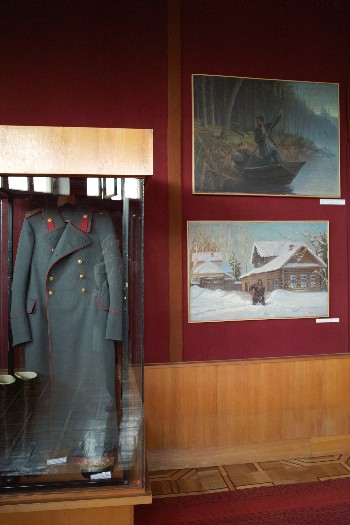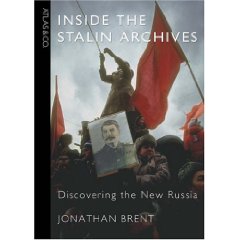Book Review: A Sane Sense of a Warped World
By Anna Razumnaya
An erudite, absorbing, and often very funny account of Russia’s pathological inability to condemn the Communist Party.
Inside the Stalin Archives: Discovering the New Russia, by Jonathan Brent. Atlas & Co. Publishers, 335 pages
A certain jealous vigilance is to be expected when a Russian reads a book about Russia written by an American. I first opened Jonathan Brent’s “Inside the Stalin Archives: Discovering the New Russia” in a skeptical frame of mind brought on by the book’s bombastic title and the cover photo of a Communist rally: colorless male figures with faces disfigured and emptied of affect by years of hard drinking, holding up blood-red flags and—the focal point of the photograph—a portrait of Stalin. This packaging, presumably adopted by the marketing department of Brent’s publisher, Atlas & Co., is both in agreement and in a peculiar tension with what the author has to say in what proves to be an engaging and serious short book.
“Everything should take place slowly and incorrectly so that man doesn’t get a chance to start feeling proud, so that man is sad and perplexed,” Brent quotes Venedikt Erofeev, a cult writer of the perestroika years in Russia. His own impressions of the Russian society, its bureaucratic underbelly and ideological underpinnings, are filtered through the prism of a Kafkaesque sensibility that complements Erofeev’s ethos.
There is, of course, no such thing as the vaulted-ceiling, Brothers-Grimm-meets-Hollywood “Stalin archives” that the book’s title suggests. Stalin’s personal archives—funds, in archive-speak—exist and are preserved under the auspices of RGASPI (formerly the Central Party Archive) among scores of other documents pertinent to the history of the Communist regime. This is not to diminish the responsible and thoughtful reporting one finds in this book. Most of the action—and there is a lot more of it than one might expect given the subject—takes place not so much inside as at the figurative gates of the various Moscow archival institutions Brent engaged from 1992 onward as the editor of Yale’s Annals of Communism series. His negotiations with the gatekeepers are recounted with a keen eye for detail and frequently with memorable insight and wit.
It is the subtitle that is true to the book’s substance: Brent does “discover the new Russia” in observing the contemporary Russian state’s official position with respect to its communist past. This position reveals the way today’s Russia treats information about the old regime. Archives, as repositories of such information, and their functioning and accessibility are at the heart of this matter of the new Russian ideology.

A sculpture of the Soviet dictator at the Stalin Museum in Gori. (Photo: Anna Razumnaya)
In his mission of excavating relevant historical material for the Yale series, Brent is uniquely well-positioned to observe Russia’s festering post-Communist predicament. One of the key encounters in the book is the author’s acquaintance with Aleksandr Yakovlev, a member of the Gorbachev administration and the engineer of the trial of the Communist Party—Russia’s equivalent of the Nuremberg Trial—meant to take place in 1992 but ultimately thwarted by the forces of political stagnation. Concerning this failed trial, Brent remarks:
No other state-sponsored project of national introspection and reconciliation has ever taken place. Unlike Germany, de-Nazified after World War II, Russia has never been completely de-Bolshevized. Instead, a widespread effort is underway to “normalize” the Soviet past.
Brent observes the manner in which this perversion plays out as aggressive nationalism evident as an undercurrent of the Russian day-to-day. The reader is made to share the book’s dismay at the rampant and unselfconscious anti-Semitism of extremist tabloids readily available from any newspaper kiosk. (Having never picked up such a tabloid myself, I can nevertheless recall the rental classifieds of the mainstream papers replete with phrases like “no Caucasians need apply”—the “Caucasians,” of course, understood to be ethnic minorities with origins in the Caucasus— Armenians, Georgians, Osetians, etc.) A bout of toe-curling embarrassment is triggered by the description of a circus act at the famous Circus on Tsvetnoy Boulevard:
“My Old Circus, My Love,” as the colorful brochure calls it, was founded in 1880 and has an honored place in Moscow cultural life. At the performance I attended, probably half the audience consisted of foreign tourists; many if not most were American and of these many were Jews . . . . When the chimpanzees came on stage, their antics immediately produced hilarity. One of them appeared wearing a white yarmulke along with awkwardly improvised payos, and danced the hora around the stage to traditional Jewish music. The foreigners in the crowd fell silent . . . . Was I supposed to find this funny—the little Jewish chimp dancing around the ring? But should I become upset while my Russian friend, with whom I had gone to the performance, found nothing objectionable? When I later pointed out to my friend that no other “religious group” had been mocked, he said, but the Jews aren’t a religious group. In Russia, they are a national group. . . .
During a trip to Georgia that took place days before the brief war between Russia and Georgia in the summer of 2008, my companion and I took a day trip to Gori—the Georgian town that was once a humble village where the boy who later became Stalin was born. Gori’s main attraction is its Stalin Museum—an impressive compound enclosing at its heart a low-slung wooden shack where it all began. The museum’s main building is an imposing space with cool, sweeping marble staircases and rows of rooms filled with photographs, newspaper clippings, maps, paintings of Stalin at various ages—Stalin as a boy surrounded by enraptured friends, Stalin as a young revolutionary shoveling the deep snow of distant exile, mature Stalin with his mother, Stalin at the Party Congress, Stalin with his daughter and with Soviet children—and Stalin’s personal possessions, preserved and displayed with enviable care and attention to detail.

The exhibits in Gori present an apparently unchanged vision of the productive and triumphant life of the beloved native son. (Photo: Anna Razumnaya)
The long portico, where stray puppies napped curled up in the shade on our visit, leads the visitor to Stalin’s personal train car—a tastefully plush car where the Father of Nations thought about the future of the country while traversing its vast spaces. Nowhere in the Gori museum was there a hint of critical reflection upon Stalin’s gory role in Soviet history. The exhibits appeared unchanged for decades in narrating the productive and triumphant life of the beloved native son.
When visiting the Stalin exhibit at the Museum of Revolution in Moscow, Brent encountered the same lack of a “guiding point of view: “nothing in the exhibit—no handout or narrative posted on the wall—indicated how to judge the man or his accomplishments.” Although in the up-to-date Moscow exhibit Stalin the hero was depicted next to Stalin the engineer of artificial famine and the gulag, there was the same curious indecision in framing the exhibit:
The purpose may have been to confront the viewer with the injunction, “Judge for yourself.” But this act of seeming high-minded social responsibility evades responsibility. Was Stalin, in fact, a hero of the revolution? Was he a hero of the Great Patriotic War—or was he responsible for one of the greatest military blunders of all time in allowing Hitler to invade unopposed on June 22, 1941? Can any of Stalin’s accomplishments be justified in the light of the horrors he produced? These are not simple questions to answer, and they are certainly not, as the exhibit suggests, self-evident.
It seems needlessly charitable to take such a soft view of Stalin as to say that these answers are not self-evident. The trouble with the exhibits in Gori and in Moscow alike is that they shy away from confronting the self-evident truth. It is symptomatic of the same public apathy that when the body of Aleksandr Solzhenitsyn lay in state at the Russian Academy of Sciences the day after my return from Georgia, only a trickle of people walked through the room to bid their farewell to the great writer and outspoken witness of the Communist Party’s crimes against the people. The rainy day could not excuse the fact that the plaza surrounding the building was nearly empty. Conceivably, a similar trickle of people could have been passing at the very same time through Lenin’s Mausoleum in the Red Square. The laxity of civic feeling, the indifference and cynicism with regard to politics, all mask the deep untreated wounds in the Russian national consciousness.
Reflecting on the origins of communism, Brent returns several times to the 1918 diary of the tsarina, which chronicles the surreal monotony of final days of the Romanov family, punctuated by striking shifts in the reality of the country outside the walls of their confinement. “At 10 they told us it was 12,” she wrote when the daylight savings time was decreed by Lenin for the first time in Russian history. “When Kafka’s Gregor Samsa wakes up to discover that he had been turned into a giant beetle, he tries to restore order in his life by vainly attempting to “get up, because my train leaves at five.” But when he glances at his alarm clock he understands for the first time that something is terribly amiss. . . .” Brent remarks on the head-spinning transformation of the country where the royal family was two hours closer to its execution because of daylight savings.

A glass case at the Stalin Museum filled with the tyrant’s personal stuff — cigars, pipes, the pen he used at the Potsdam conference; the photo ID on display is of his wife, Nadezhda Alliluyeva, who committed suicide (unacknowledged by the exhibit). (Photo: Anna Razumnaya)
In the revolutionary moment, Russia was transformed into a country where terror took the place of morality. Inevitably, this radical break with the past produced a fascination, a violent charisma, whose remnants became a highly marketable brand of pastiche after the fall of the Soviet Union. In the eyes of the West, Russia is destined to remain a specter of gory kitsch and vaguely alluring violence embodied in red stars and black leather, until it faces the demons of its history instead of exporting them as the national brand of cool. (American youngsters who favor “CCCP” t-shirts and have no qualms about wearing World War II medals as jewelry should pause to think about what they are wearing and why.)
One of the signals of such a change of consciousness in Russia would be the burial of Lenin, but, for the moment, his enshrined if no longer venerated body continues to testify of the Russians’ pathological inability to condemn communism once and for all. “Inside the Stalin Archives” raises this issue with a remarkable degree of insight, but sadly, it does not presume to get the attention of its American readership without capitalizing on the kitsch appeal of Russia (which is precisely a product of Russia’s national pathology). It is nevertheless an erudite, absorbing, and often very funny account of an adventure in making sane sense of the strange, the foreign, and the bizarre. Lightly, almost as an afterthought, this book points out deep truths about Russia’s ongoing ideological crisis.

